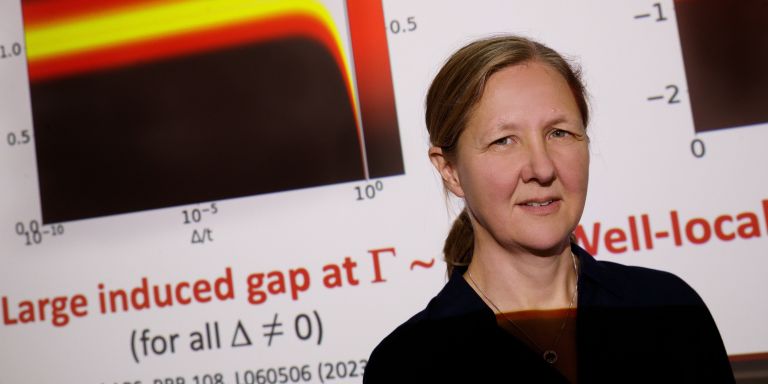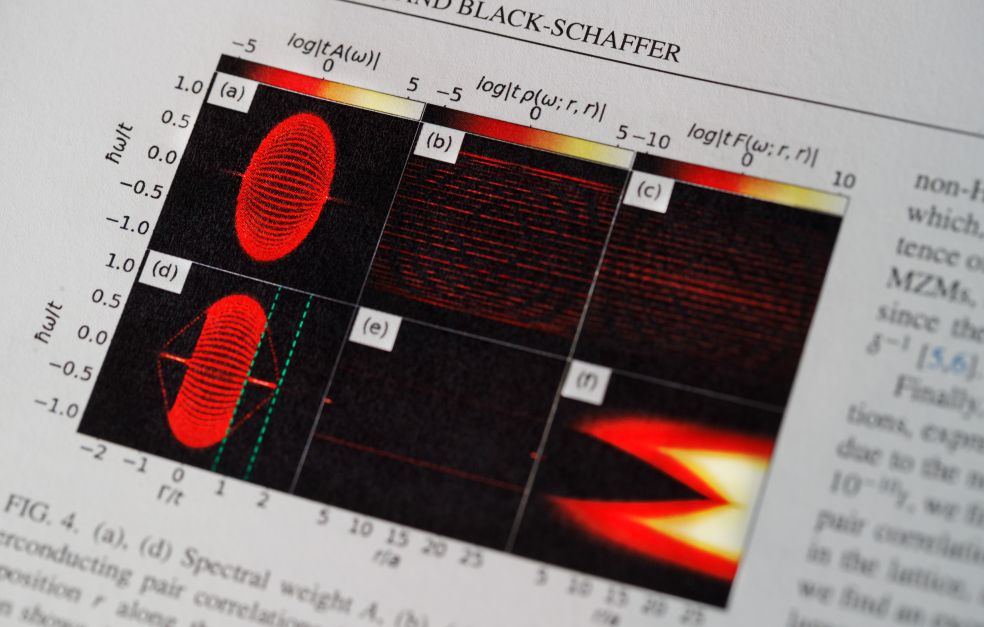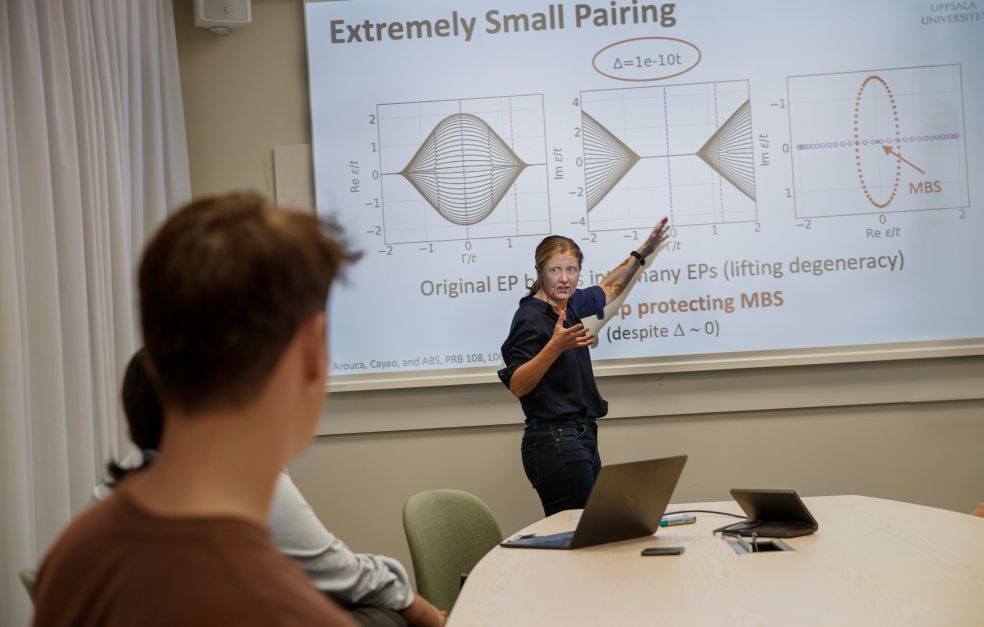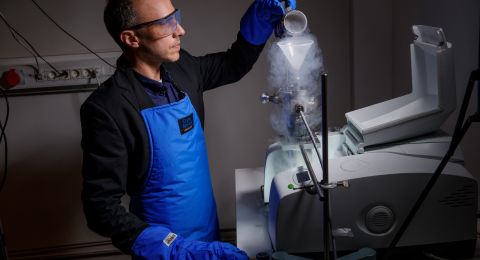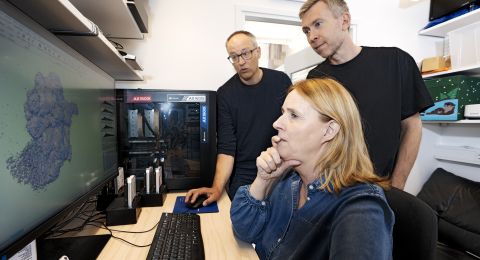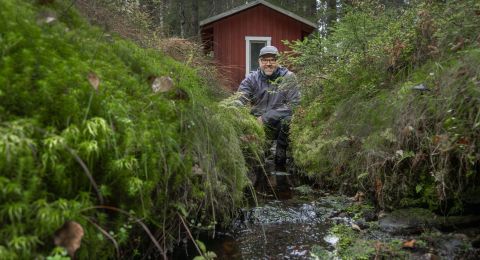Superconductivity is a fascinating phenomenon in which certain materials conduct electrical current without any electrical resistance. Traditionally, open systems have been seen as an obstacle to superconductivity and other quantum mechanical effects. But what if open systems could instead be used to amplify these phenomena?
Annica Black-Schaffer
Professor of Quantum Matter Theory
Wallenberg Academy Fellow/Wallenberg Scholar
Institution:
Uppsala University
Research field:
Condensed matter theory, with a specialization in superconductivity
Quantum mechanical phenomena such as superconductivity and magnetism have huge potential to revolutionize electrical transmission and high-speed electronics.
With superconductivity, electricity flows through a conductor without any energy being lost as heat. Applications include quantum computers, maglev trains, and other innovative technologies.
Annica Black-Schaffer, professor of quantum matter theory at Uppsala University, wants to deepen and improve understanding of these phenomena as a Wallenberg Scholar. She is working to identify simple models that can explain the properties of entire families of materials.
Interactions between large numbers of electrons
A fundamental idea in material physics is that when large numbers of electrons interact, new quantum mechanical phenomena arise that would not be possible with single electrons.
For such an electronic ordering to occur, interaction between electrons is necessary, and the number of electrons that have zero energy is especially significant.
“The more electrons that are at zero energy, the more likely the material is to develop different types of order,” says Black-Schaffer.
Materials do not usually exist in complete isolation but are influenced by their surroundings — they are part of open systems. This openness is traditionally often seen as detrimental to quantum mechanical properties, which means that you tend not to expect to find electronic order in open systems.
“Even a grain of dust can destroy subtle quantum mechanical states and then upset electronic order, leaving only classical physics.”
Now Black-Schaffer and her colleagues are challenging the prevailing view on this and showing that openness can in fact create order. Combining superconductivity with so-called non-Hermitian effects found in open systems paves the way for new possibilities.
“We’ve found a way to take advantage of certain characteristics of open systems to amplify quantum mechanical effects – in our case superconductivity, but it could also involve other quantum mechanical phenomena, such as magnetism.”
Challenging established norms
Non-Hermitian effects are a complicated concept but can be made easier to understand with an analogy.
Imagine a person throwing a stone into a pond. The ripples the stone makes spread evenly in all directions before the water eventually becomes still again. This is similar to a Hermitian system in which energy is conserved, and everything happens symmetrically and predictably.
But if there are currents in the water that pull the ripples in different directions, or if there are obstacles below the surface that affect the motion of the ripples, they can be amplified in unexpected ways or disappear faster than otherwise would be the case. This is similar to a non-Hermitian system where energy can be added or lost, and where the system no longer behaves according to usual rules.
What drives me is solving problems about how nature behaves in matter that is all around us. There are of course applications ‘down the road,’ but mostly it’s about understanding how things work.
Non-Hermitian effects thus describe systems in which energy and information can leak in or out, creating new and surprising phenomena.
One effect that can occur is the occurrence of so-called exceptional points, where energy levels of a system converge, but where normal behaviors are disrupted with the wave functions no longer being independent of each other but instead parallel.
“This is a key non-Hermitian effect in which energies coalesce and wave functions become parallel and completely overlap each other. It’s a kind of physics that cannot arise in ordinary quantum mechanics,” says Black-Schaffer.
By creating exceptional points at zero energy, the researchers can generate large numbers of zero-energy electrons, which is exactly what you want to achieve if you want to create electronic ordering such as superconductivity.
“We’ve seen that we can achieve superconductivity much faster and stronger when we have these non-Hermitian effects.”
New theoretical framework
Work is now underway to develop a theoretical framework to improve and understand electronic order in these kinds of open systems.
Part of the research involves formulating relevant models and making calculations – sometimes with pen and paper and sometimes with advanced supercomputers.
“If you asked me what we do all day, I’d say that we sit and read, calculate, write, and program – and talk to each other,” Black-Schaffer says.
Practical applications remain a long way off, but greater theoretical understanding is an important step along the way.
Superconductivity usually occurs at extremely low temperatures, close to absolute zero at minus 273 degrees Celsius. A dream scenario would be to discover materials that become superconductive at higher temperatures, which could revolutionize everything from quantum computers to electrical transmission.
“Superconductivity at room temperature is the holy grail that offers enormous potential. For example, solar cells located great distances from Sweden transmitting electricity all the way here, even when the sun is not shining here,” Black-Schaffer explains.
For Black-Schaffer, it all comes down to problem solving.
“We hope to provide some pieces of the puzzle. The most important thing is that the research leads to a better fundamental understanding of how nature works.”
Text Nils Johan Tjärnlund
Translation Nick Chipperfield
Photo Magnus Bergström

